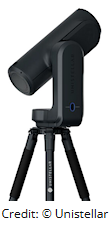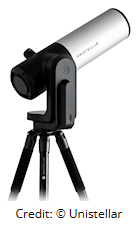 The Unistellar Odyssey and Odyssey Pro are smart telescopes that were introduced in 2024 and are capable of observing nearby planets in addition to galaxies, nebulae and star clusters. Compared to eQuinox 2 and eVscope 2, Odysseys are smaller and lighter—making them more portable—and include three additional technologies: Stellar Autofocus, Nikon High Precision Optics and Multi-Depth Technology.
The Unistellar Odyssey and Odyssey Pro are smart telescopes that were introduced in 2024 and are capable of observing nearby planets in addition to galaxies, nebulae and star clusters. Compared to eQuinox 2 and eVscope 2, Odysseys are smaller and lighter—making them more portable—and include three additional technologies: Stellar Autofocus, Nikon High Precision Optics and Multi-Depth Technology.
Intended for users of all skill levels, the Odyssey and Odyssey Pro have an 85 mm aperture, 320 mm focal length and an f/3.9 focal ratio. These Newtonian reflectors are said to be the first mirror telescopes to not require focus or collimation adjustment. The parabolic mirrors, made from aluminum coated technical glass, are sealed in the optical tube. This process ensures that the Nikon High Precision Optics will remain perfectly aligned regardless of changes in temperature or any vibration to which the telescope may have been subjected. As a result, light loss is minimized and objects are more detailed without chromatic aberration.
 Designed for expert astronomy enthusiasts, the Unistellar eQuinox 2 was released in 2023 and the eVscope 2 in 2022. They are also Newtonian reflectors but have a larger 114 mm aperture, 450 mm focal length, f/4 focal ratio and offer maximum sensitivity. They do require focus and collimation adjustments.
Designed for expert astronomy enthusiasts, the Unistellar eQuinox 2 was released in 2023 and the eVscope 2 in 2022. They are also Newtonian reflectors but have a larger 114 mm aperture, 450 mm focal length, f/4 focal ratio and offer maximum sensitivity. They do require focus and collimation adjustments.
The 3.4 megapixel color camera in the Odyssey and the 4.1 megapixels in the Odyssey Pro capture a 0.56° x 0.75° field of view. The eQuinox 2 and eVscope 2 color cameras have a similar field of view—0.57° x 0.76°—and 6.2 megapixel and 7.7 megapixel resolutions, respectively. These fields of view are the narrowest among the different smart telescope models and are sized for planets in our solar system, like Saturn and Jupiter, and galaxies and nebulae. Storage capacity for all models is 64 GB and the four supported image file formats are JPG, FITS, TIFF and PNG.
An exclusive feature of a smart telescope is the eyepiece on the Odyssey Pro and eVscope 2 models. The result of a collaborative effort between Nikon and Unistellar, Nikon Eyepiece Technology is an assembly consisting of four spherical and aspherical lenses and an OLED micro-display with an ultra-high contrast ratio of 100,000:1 that is not subject to optical aberration. As Unistellar explains, images are projected to infinity and "Because optical infinity is the natural resting position of the human eye, our eyepiece eliminates ophthalmic fatigue and the discomforts of prolonged observation."
Install Unistellar's mobile app on your smart device to control and view processed images in real time. Smart Star Finder is a function that uses your smart device's GPS to determine its terrestrial location and a star database to accurately pinpoint its field of view on a sky map even with a minimal number of visible stars. In less than a minute it will locate and track a celestial object you select in the app or you may navigate to one of your choosing. A solar experience has been added to the app and requires the Smart Solar Filter accessory.
Unistellar engineers joined with Nikon to develop Stellar Autofocus, which consists of an innovative focusing algorithm, digital sensor and micromotor. Sharp images are assured because the system will refocus as needed even during periods of observation and despite adverse viewing conditions.
Image resolution is increased by a proprietary technology called Amplified Resolution. Using the newest image processing techniques, the algorithms remove photographic noise and enhance the signal to reveal detail and improve sharpness.
Dynamic Signal Amplification amplifies celestial light and only the relevant signal will appear in the final image. This is accomplished by short exposures that are continuously stacked and processed using exclusive algorithms. The "algorithms have learned to recognize the behavior of the light signal emitted by celestial objects," Unistellar says.
City light pollution is mitigated by a proprietary denoising algorithm called Deep Dark Technology. Exploiting data from thousands of user observations, the image is analyzed and algorithms remove offending components based on their ability to differentiate between light pollution and light from celestial objects. Even in harsh light-polluted cities like Las Vegas and Tokyo, objects are distinct and the background is a deep black.
Unistellar's patented Multi-Depth Technology sets Odyssey smart telescopes apart because they can be used to observe nearby planets in addition to distant galaxies, nebulae and star clusters. A process called binning groups four contiguous pixels to form a larger pixel while an algorithm boosts sensor sensitivity allowing the device's resolution and sensitivity to be optimized for the object being observed. A dedicated Planetary observation algorithm combines rapid short shots to create a detailed and sharp image that is more colorful.
The Goto Sun and Sun Tracking technology, which requires the optional Smart Solar Filter, uses a brightness gradient detection algorithm to accurately locate, center and track the Sun. Even when obscured by clouds, the Sun's theoretical position is used to predict its movement. During a total eclipse, the eVscope and eQuinox automatically adjust exposure based on calculated light gain so the solar corona can be viewed without removing the filter.
The newest feature is Vivid Vision, which combines two technologies to authentically replicate cosmos colors and automatically correct image imperfections. And, using colors from the Gaia DR3 catalog, the algorithm has been validated to ensure accurate color rendering.
Precision optics, a sensitive image sensor and real time image processing are combined using a patented system called Optical Digital Hybrid. Dynamic Signal Amplification, Amplified Resolution, Deep Dark Technology and Smart Star Finder create a cohesive system optimized for exploration of objects in both deep space and our solar system.
The internal rechargeable battery provides power for up to 5 hours for both Odyssey models, 11 hours for the eQuinox 2 and 9 hours for the eVscope 2. Their mount is an alt-azimuth and they are supplied with a premium high tripod. Odyssey and Odyssey Pro dimensions are 17 in. x 8 in. x 5.3 in., telescope weight is 8.8 lbs and the tripod is 5.5 lbs. eQuinox 2 and eVscope 2 measure 25.6 in. x 7.5 in. x 9.1 in., the telescope is 15.4 lbs and the tripod is 4.4 lbs. An optional backpack can accommodate the telescope, tripod and accessories.
The Technology table summarizes which technologies are incorporated in each model and the Specifications table lists technical and mechanical details.
To learn more about the Unistellar Odyssey, Odyssey Pro, eQuinox 2 and eVscope 2 and for upated information, visit the Unistellar website.
Product Overviews, which are based solely on manufacturer-supplied data, have been reviewed by the manufacturers, provide significantly more detail than Product Reviews and do not include personal opinion.